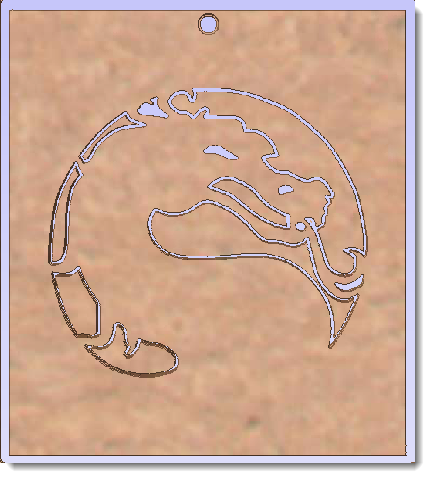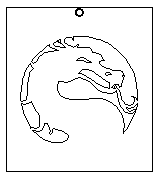It’s empty, just a shell for now, its not full size, it’s a half pint around 4ft tall, less of an eye sore and easily portable.
Something for my office if i get a urge to get some old school arcade in.

It’s empty, just a shell for now, its not full size, it’s a half pint around 4ft tall, less of an eye sore and easily portable.
Something for my office if i get a urge to get some old school arcade in.
That tabletop arcade looks awesome! We could just have a class on building arcade cabinets (I’d love a MAME build class)
Well I am interested,but the mention of vectors and such makes little sense to me, in regarding to making things.
Can someone link to something that explains this better to this old lady? I have ideas that I want to make, I just need to understand the software more. Not very computer literate here.
Y’all should have seen me last night with photoshop. I got a little done even with some earlier one on one coaching.
Classes in some of the software maybe, please?
In this context vectors basically means “vector graphics” like CAD programs (and vector graphics programs like Inkscape and Adobe Illustrator) use: https://en.wikipedia.org/wiki/Vector_graphics
…as opposed to raster or pixel graphics which is more like Photoshop (or the powerful MSPaint!).
Pixels are essentially little blocks of color where as vector graphics are more about the mathematical representation behind what you’re drawing. In vector graphics, you essentially have infinite resolution. You could blow up an image 1000 times and it will look just as good. With pixel images, the same is not true (you would start to make out every pixel as a big rectangle essentially.
The laser cutter for instance follows vectors for cutting out shapes. The laser will do raster graphics with pixels and ends up just pulsing the laser as it moves left to right/top to bottom (scanline).
For something like a router, scanline isn’t really an option. There are ways you could kinda do raster, but it’d be crazy inefficient and end up not looking very good (you’d be better off with stippling). Instead a router wants to follow paths based upon vector graphics.
I hope that explains more than confuses, but it’s kinda tricky explaining it…
Sort of and from physics, I figured that vectors are direction. Any sources to learn more? I can learn a lot on my own, I tend to learn better from written rather than a YT. (unless I understand the process). Learning some CAD has long been on my to do list.
This is one of the reasons I LOVE MS, I have the the opportunity to LEARN new things.
Lynda has a bunch of cad courses that would interest you.
Don’t let the word “vector” throw you. A more descriptive term may be parametric, but vector is much easier to say.
Instead of storing the image as a big matrix of dots, a “vector” program maintains a list of abstract figures, each with a location and size. For example, a line segment from point A to point B. Or a triangle from point C to point D to point E and back to point C. Or a circle surrounding point F with a radius of G units.
In a bitmapped or raster image as edited in Photoshop or Gimp, it may be difficult if not impossible to manipulate an embedded line segment, triangle or circle. In a vector tool, simply click on an element to select it, then drag or stretch it.
What do I need to do to access Lynda? I think my computer could handle them, maybe.
More like thinking in quads and mapping in it, I guess.
Look here:
Odd. I just imported a DXF created using AutoSketch. It worked beautifully.
I honestly think this is more about the source of the DXF’s he tried than DXF import in general. I’ve had it work flawlessly, but there are SO many versions of DXF’s (multiplied by 2 for ASCII/binary) and it’s mostly a reverse engineered format in many cases.
I think you’re right. I find it funny (I know diddly about programming at that level) because DXF is a published file standard.
edit: by published I mean you can just go download the standard from Autodesk with a quick Google.
Yes, i should of been more clear, dependent of the file type, you may run into open vectors. Not all file types pose this problem, however vcarve will not calculate the tool path on an open vector anyway. The software also offers a few tools to help remedy that issue.
I imported a .dwg and it was full of open vectors, but it could be that file only. Regardless, i wanted to bring that point up as a red flag in case anyone else ran into.
@Kentamanos - I now have a full understanding of the Z-Zero bottom.
You have to set surface as the top of the spoilboard and you dont have to set max depth on the machine. Max depth set on the machine is a soft setting or secondary safety net to avoid cutting through the spoilboard, but not required for z-zero bottom jobs. The hard setting is actually done in the software and we all know vcarve redflags if any of your toolpaths are deeper than your material thickness
So if you have 1" material and you set your z zero to the spoil board, the machine will compensate for the 1" material height and start carving from 1" above the spoil board.
All this does is change the way Vcarve computes the toolpaths. Makes NO difference to the actual cuts. The most common way among experienced CNC users is to leave the Z0 to the spoilboard, because then you never have to worry about cutting into your spoilboard, and you never have to measure Z0, its just always the same at the spoilboard. The reason to set Z0 to the top of your material is if you don’t know the exact thickness of the material and need your cuts to be an exact distance into the material (with fine v-carvings, for example).
Simply put, VCarve does the math for you when it comes to setting Z zero. When you set it to the top of the material all Z cuts that are into the material will be a negative value (below zero). If you set it to the spoilboard all Z cuts will have a positive value (above the Z zero). (answers your concern about the negative and positive conversions)
Also, you recall my file was in portrait mode, there is setting on the machine to rotate the data so the machine reads it in landscape so you can design in portrait and leave it in that state.
I get setting the workpiece offset etc. (in other systems setting the G54 for instance is more obvious) and I realize that it will generate different GCode if you use top or bottom. For instance, if you use top (which we normally do), all cuts will be in positive Z (remember Multicam positive Z is into the board), if you use bottom, all cuts will be in negative Z (or zero for final pass).
What I don’t get is what happens to the protections you normally get when you set top and bottom on the Multicam. Part of the benefit of setting the bottom is no matter what your GCode says, it will never go below that. So even if your GCode says “go in 5 inches”, the controller will only allow you to go in as deep as the bottom surface.
What I don’t know is how this is affected by setting the bottom as the top of the surface and the top as the bottom. Does it take the deepest of the two as the maximum it will go in, or do you lose the protection the controller typically gives you?
This is something I just need to test out, but to be honest, I’m still not sure when I’d even want to use that setup. I’d rather trust the traditional top and bottom we’ve been using and then set my paths in VCarve a bit deeper than thickness to make sure I get thru. The controller will keep me from digging into the spoil board too much.
I read what you added and get that part. I’m just not ready to part with that added protection the controller puts in IF (still don’t know) I lose it swapping the top and bottom.
In theory, the machine would then not allow the machine to go into positive Z, but I don’t know if it actually does that. Just something I want to test.
CNC user group in Fort Worth next meeting ( don’t remember when) is about VCarve and Multicam.
Its not be used with perfectly flat surfaces, its more for material with irregular surfaces, think of it as using the surfacing function for the spoilboard. It’s probably for more finite carving where the surface depth your cutting is super important. It’s just nice to understand all of the functionality in case that need ever comes up, especially when the space gets aspire.
The rotate function is pretty cool though. Its hard to design a project on a full sheet in landscape mode
Not too sure about this. My understanding was that setting minZ and MaxZ were more about indexing the tool, since each new tool install changes both values. And while vcarve will regulate the depth of cut relative to the MinZ (assuming default z coordinates), it provides no protection if you get your material thickness wrong (aka assuming a .72 board is 3/4’s thick) or if the material is cupped etc. I think setting both requires so little effort, there’s really no circumstance where skipping one would be a good idea. I do understand your point about bottom zero jobs, but I think best practice is still to set both depths for every tool, particularly for new users.
I totally agree with your logic as well, i’m not totally sold on the explanations until we test it out somehow. I agree there should be a surface and max depth set.
This is an advanced method for the machine, definately not for the novice, as it requires taking steps not of the norm, and more attention to detail in regards to the vcarve settings.
I had asked @Kentamanos if the logic for the max depth would be measured from the top of the the material, if you set z-zero at the bottom, which the quote below mentions all z cuts will have a positive value, which means its been reversed in the software and applied to the machine g-code. Maybe setting max depth on top of the material would give you that safety net, but realistically the bottom z-zero is supposed to be use for irregular surfaces, which is why max depth set on the cnc would help much as the material would not be the same as where you put the grounding block.
My interest here is basically having an option and nobody knows what it does, and when it does get used, the bit just hovers over the material and doesnt cut, its there for a reason, just ignoring could be ignoring a cool factor on what the machine can actually do…especially in 3d…
im messing aroung with bitmaps etc, so the more i understand the better.

